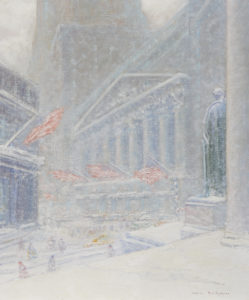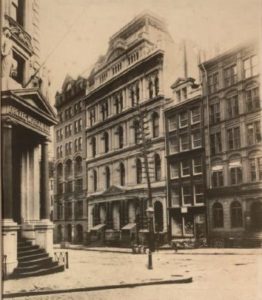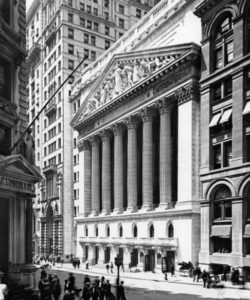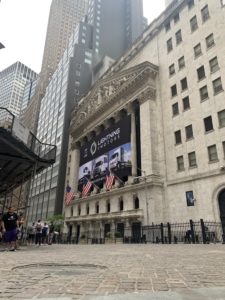For this week’s Architecture in Art, we’re down on Wall Street taking a look at one of the most iconic buildings in the city through the work of Johann Berthelsen – the New York Stock Exchange.
Broker-to-broker securities trading in New York dates back to 1792 with what is known as the Buttonwood Agreement. But it wasn’t until 1817 that the Stockbrokers of New York would adopt formal policies on rules of governance. Reforming as the New York Stock and Exchange Board, the organization began renting space exclusively for securities trading.
In the early 1800s, there were several regional exchanges, but the invention of the electric telegraph led to a consolidation of the market. New York eventually rose to prominence over Philadelphia with the highest volume of trading, meaning greater liquidity. Through the end of the century, there was rapid growth in securities trading, especially speculative trading.
The NYSE used several locations between 1817 and 1865… following that period, the exchange moved to 10 Broad Street. Soon after, 12 Broad Street was acquired and combined with the original building; there would be two more expansions before the NYSE acquired 16 & 18 Broad Street in 1898. Following the newly acquired property, the NYSE planned to demolish and rebuild a brand new building… the cornerstone was laid in 1901 and construction took two years.
While the NYSE had a shiny new building, it faced many difficulties at the turn of the century. High levels of speculative trading created a great deal of volatility, which made securities prone to panics and crashes. The first major event, known as The Panic of 1907 resulted in a 50% loss of value. Shortly after, there were two federal investigations in 1909 and 1912, which resulted in the Federal Reserve Act. Then came the start of World War I. Even still, the NYSE persisted… in fact, it grew significantly, forcing another expansion by the 1920s. That all changed in 1929 with the ‘Great Crash’, cited as one of the causes of the Great Depression. It would be decades before the NYSE recovered to the levels seen in the 1920s.
Eventually, the NYSE would go on to expand again in 1954, 1967, 1985, and 1998 before electronic trading began to limit the need for more space; today, its total footprint accounts for more than 31,000 square feet. It is the world’s largest exchange, with a market capitalization of $22.1 trillion (as of Oct 2022), and sees trading volume range from 2-6 billion shares per day. Currently, the exchange sits in a pedestrian-only zone (post-9/11); it is designated a National Historic Landmark, a New York City Landmark, and is included in the National Register of Historic Places as part of the Wall Street Historic District.




